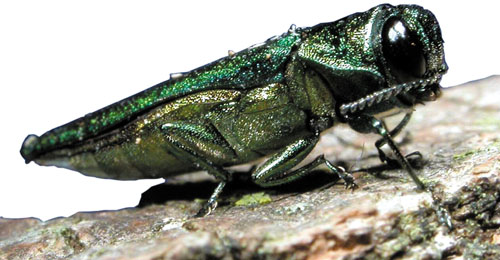- App Content / News
- News
- News / Politics And Administration
- News / Politics And Administration / Campus
- News / Politics And Administration / City
- News / Politics And Administration / State
Tree-killing bug returns to Ames
June 8, 2018
In a time defined by many scientists as earth’s sixth mass extinction, another once-abundant species is being threatened.
American ash trees are facing potential extinction at the hands of the Emerald Ash Borer (EAB), an Asian beetle which first appeared in the U.S. in 2002. Since then, EABs killed hundreds of millions of ash trees in the U.S. and Canada, according to the federal webpage emeraldashborer.info.
Evidence of EABs in Ames was found in 2010, and after a brief hiatus the metallic green beetles are back.
“Without treatment or protection, all the ash trees will die,” said Donald Lewis, etymology professor at Iowa State. “EABs evolved to eat the cambium, or living tissue, of ash trees. Our ash trees haven’t evolved a resistance, because they had never seen the beetle before.”
Ash trees can be found in yards and forests across North America. Many of them were planted after a majority of America’s elm trees were lost to Dutch Elm disease, a fungal pathogen which nearly drove the tree to extinction.
Although the EAB threat is different, it is still just as dangerous. They lay their eggs in the upper parts of ashes, and their larvae burrow between the bark and the wood of the tree and continue tunneling, consuming what tissue they can.
“One tunnel isn’t a big deal,” Lewis said. “But if you have hundreds or thousands of tunnels networking under the bark, it cuts off water from traveling throughout the tree, and it dies from the top down.”
This kind of decay can take years to kill a single tree, but even the healthiest of ash trees can’t withstand EABs. It’s also difficult to detect when a tree is infected since the decay comes from the top down.
Ash trees don’t have to share the fate of elm trees, however. Lewis explained that there are treatments available which can help preserve them from severe population loss.
“The difference between this [EABs] and Dutch Elm disease is that we have good tools for defending ash trees,” Lewis said. “It’s time consuming and costly, and we can’t save them all, but it can be done.”
These treatments consist of injecting insecticides, either into the soil or directly into the tree. The ash tree has no natural defenses against the beetle.
There are natural EAB predators which could help control their population. Lewis wrote about this in an FAQ on the Iowa State website.
“Scientists have observed parasitic wasps attacking the egg or larval stages of the emerald ash borer in its native land,” Lewis wrote. “Efforts are underway to determine if these wasps can be introduced to America to control these beetles. Unfortunately, this process is time-consuming and may not be available to current eradication and containment efforts.”
In the past, the university removed hundreds of ash trees from the campus. Lewis said people can expect more trees to be removed as the EAB persists, but this shouldn’t be cause for worry.
“We have so many trees on campus,” Lewis pointed out. “We’re in the middle of an urban forest. For every tree the university removes, they’ll replace it with something else. We have thousands of shade trees on campus.”
The U.S. and Iowa Departments of Agriculture, the Iowa Department of Natural Resources and Iowa State University have been working together since 2005 to deal with the EAB threat. As an urban etymologist, Lewis has been assisting by studying, preparing and teaching about EABs.
“Without help, the beetle will win,” Lewis said. “But we have tools at our disposable, and we will save those that are healthy.”







